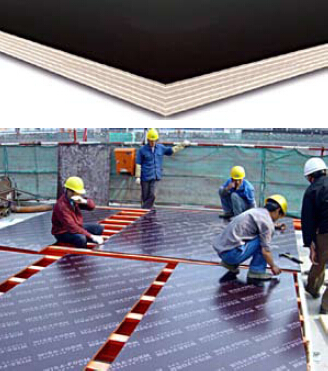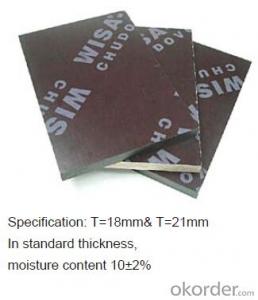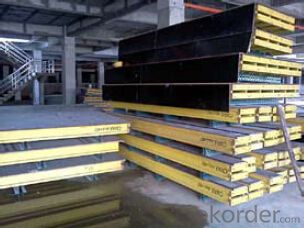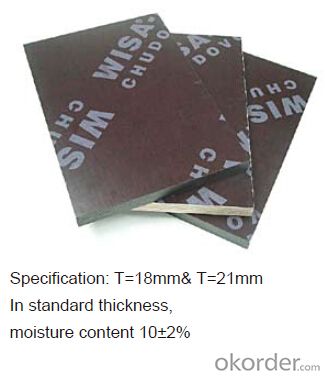Plywood-formwork system for formwork and scaffolding
- Loading Port:
- Tianjin
- Payment Terms:
- TT OR LC
- Min Order Qty:
- 50 m²
- Supply Capability:
- 1000 m²/month
OKorder Service Pledge
Quality Product, Order Online Tracking, Timely Delivery
OKorder Financial Service
Credit Rating, Credit Services, Credit Purchasing
You Might Also Like
Plywood --- make perfect concrete surface
WISA-Form Birch is a coated special plywood using in the formwork systems where high
requirements are set on the concrete surface and the times of reuses.
With CNBM timber beam & WISA plywood, the formwork is low weight but high load capacity, it is
widely used in construction.
Characteristics:
◆ Component with high standardization.
◆ Assembling in site, flexible application.
◆ Light weight, easy transportation and storage.


- Q: Can steel formwork be used for curved or irregular shapes?
- Yes, steel formwork can be used for curved or irregular shapes. Steel is a highly flexible material that can be easily manipulated to create various shapes and sizes. It offers excellent strength and durability, making it suitable for withstanding the pressure exerted by concrete during pouring and curing. To form curved or irregular shapes, steel formwork is usually fabricated using modular panels that can be adjusted or bent to the desired shape. These panels can be easily connected together to form a continuous surface. Additionally, steel formwork can be customized and welded to create complex shapes that perfectly match the architectural design requirements. The versatility of steel formwork allows it to be used for a wide range of projects, including buildings, bridges, tunnels, and dams. It provides a high-quality finish and can be reused multiple times, making it a cost-effective solution for projects that require repetitive shapes or structures with unique geometries. In conclusion, steel formwork is an excellent choice for creating curved or irregular shapes. Its flexibility, strength, and durability make it a reliable option for construction projects that require complex and customized formwork solutions.
- Q: How does steel formwork handle formwork stripping and cleaning?
- The durability and strength of steel formwork make it highly suitable for formwork stripping and cleaning processes. When it comes to removing the formwork, steel formwork can be easily disassembled and taken off the concrete structure without causing any damage. This is possible because steel is inherently rigid and stable, allowing for efficient and safe stripping. In addition, steel formwork is resistant to moisture, chemicals, and other environmental factors, which makes it easier to clean and maintain. Once the formwork is stripped, any concrete residue or debris can be easily cleaned off the steel surface using appropriate cleaning techniques. This may involve using high-pressure water jets, scrubbing, or other cleaning agents, depending on the specific requirements. Furthermore, steel formwork can be reused multiple times without significant deterioration. After cleaning, the formwork can be inspected for any damages or wear and tear. Any necessary repairs or replacements can be made to ensure the integrity of the formwork for future use. Overall, steel formwork is an efficient choice for handling formwork stripping and cleaning due to its durability, strength, and resistance to environmental factors. Its easy disassembly, cleaning capabilities, and reusability make it a preferred option for construction projects where regular formwork stripping and maintenance is required.
- Q: Can steel formwork be used for curved or complex shapes?
- Yes, steel formwork can be used for curved or complex shapes. Steel is a highly versatile material that can be easily shaped and molded to fit various geometries, making it suitable for constructing formwork for curved or complex structures. Its strength and durability also make it a reliable choice for these types of applications.
- Q: What are the different accessories and attachments available for steel formwork?
- Steel formwork in construction projects can be made more efficient and functional with the use of various accessories and attachments. Some commonly used ones are as follows: 1. Wedges and pins: These are utilized to tightly secure and connect formwork panels. Wedges are inserted into slots on the panels, while pins lock the wedges in place. 2. Formwork clamps: These clamps firmly hold the formwork panels in position during the concrete pouring process, ensuring stability and preventing movement. 3. Formwork ties: These connections vertically join the formwork panels, adding strength and stability to the structure. Ties are available in different lengths and materials, such as steel or plastic, to accommodate various formwork heights. 4. Formwork braces: Braces support and reinforce the formwork system, preventing collapse or buckling under the concrete's weight. They are adjustable in length and can be easily installed and removed as needed. 5. Formwork corners and angles: These accessories create precise corners and angles in the formwork, ensuring accurate pouring and desired dimensions. 6. Formwork spacers: Spacers maintain a consistent gap between the formwork and reinforcement steel, ensuring proper concrete cover and preventing contact between the two. They are easily adjustable and come in different sizes. 7. Formwork release agents: These agents are applied to formwork surfaces to prevent concrete from sticking. They aid in the easy removal of the formwork after the concrete has cured, minimizing damage to the panels. 8. Formwork handles and lifting devices: These attachments assist in transporting and positioning formwork panels. Handles provide a secure grip for manual handling, while lifting devices allow for the use of cranes or other machinery. Overall, these accessories and attachments are vital for the proper installation, stability, and functionality of steel formwork systems. They improve efficiency and safety in the construction process, enabling the creation of high-quality concrete structures.
- Q: How does steel formwork contribute to the overall stability of the structure?
- Steel formwork contributes to the overall stability of a structure in several ways. Firstly, steel is a highly durable and strong material, making it capable of withstanding significant loads and pressures. This strength ensures that the formwork remains intact and stable during the construction process, even when exposed to heavy loads such as wet concrete. Secondly, steel formwork provides excellent dimensional stability. Unlike other materials like wood, steel does not warp or deform over time, ensuring that the structure maintains its desired shape and dimensions. This is crucial for the stability of the structure, as any deformation or movement in the formwork could lead to inaccuracies or weaknesses in the final construction. Moreover, steel formwork offers a high level of rigidity and stiffness. This rigidity helps to prevent any unwanted movement or shifting of the formwork during concrete pouring and curing, ensuring that the structure is built according to the intended design and specifications. It also helps distribute the weight and forces evenly, reducing the risk of structural failures or collapses. Additionally, steel formwork provides excellent support and reinforcement for the concrete. The steel panels and beams used in formwork act as a framework, holding the concrete in place until it hardens and gains its own strength. This support not only ensures the proper formation of the structure but also enhances its overall stability by preventing any concrete cracking or failure. Lastly, steel formwork is highly adaptable and can be easily customized to fit various architectural designs and construction requirements. This flexibility allows for the creation of complex and unique structures, while still maintaining stability and strength. In conclusion, steel formwork contributes significantly to the overall stability of a structure through its durability, dimensional stability, rigidity, support, and adaptability. Its robustness and ability to withstand heavy loads, combined with its ability to maintain shape and provide structural support, make it an essential component in ensuring the stability and integrity of any construction project.
- Q: What are the different edge protection systems available for steel formwork?
- There are several different edge protection systems available for steel formwork, each designed to provide safety and support for construction workers. One common edge protection system is the use of guardrails. These guardrails are typically made of steel or aluminum and are installed along the edges of the formwork to prevent workers from falling off. They are often adjustable in height and can be easily installed and removed as needed. Another type of edge protection system is the use of safety nets. These nets are installed below the formwork and act as a safety barrier to catch any workers or materials that may fall. Safety nets are typically made of high-strength synthetic fibers and are designed to absorb the impact of a fall, reducing the risk of injury. Some edge protection systems also include toe boards. Toe boards are installed along the bottom edge of the formwork to prevent tools, equipment, or materials from falling off and potentially causing injury. They are typically made of wood or metal and are securely attached to the formwork. In addition to these systems, there are also edge protection solutions that incorporate a combination of guardrails, safety nets, and toe boards. These comprehensive systems provide multiple layers of protection to ensure the safety of workers on the construction site. Overall, the different edge protection systems available for steel formwork are designed to prevent falls, protect workers, and ensure a safe working environment. It is important for construction companies and workers to carefully assess the specific requirements of their project and select the appropriate edge protection system to meet their needs.
- Q: Can steel formwork be used for single-sided formwork applications?
- Yes, steel formwork can be used for single-sided formwork applications. Steel formwork is known for its strength and durability, making it suitable for various construction applications, including single-sided formwork. It provides excellent support and stability to the concrete during pouring and curing processes, ensuring a smooth and efficient construction process.
- Q: What are the considerations when selecting the appropriate formwork system for a project?
- Some considerations when selecting the appropriate formwork system for a project include the complexity and size of the structure, the required quality and finish of the concrete, the project timeline, the available budget, the construction site conditions, and the desired level of reusability and sustainability of the formwork system. It is also important to consider the expertise and skill level of the construction team, as well as the safety features and ease of assembly and dismantling of the formwork system.
- Q: How does steel formwork handle vibrations from construction equipment?
- Steel formwork is known for its excellent strength and durability, which enables it to effectively handle vibrations from construction equipment. The rigid nature of steel formwork allows it to withstand the impact and oscillations caused by heavy machinery or equipment without significant deformation or damage. Additionally, the structural stability and stiffness of steel formwork help to minimize any unwanted movement or shaking during construction activities, ensuring a stable and reliable foundation for the construction process.
- Q: Can steel formwork be used for both flat and sloped concrete surfaces?
- Yes, steel formwork can be used for both flat and sloped concrete surfaces. Steel formwork is known for its versatility and durability, making it suitable for various types of concrete structures. It can be easily adjusted and shaped to create both flat and sloped surfaces, allowing for the construction of diverse architectural designs. Additionally, steel formwork provides excellent support and stability to the concrete during the pouring and curing process, ensuring a high-quality and uniform finish on both flat and sloped surfaces.
Send your message to us
Plywood-formwork system for formwork and scaffolding
- Loading Port:
- Tianjin
- Payment Terms:
- TT OR LC
- Min Order Qty:
- 50 m²
- Supply Capability:
- 1000 m²/month
OKorder Service Pledge
Quality Product, Order Online Tracking, Timely Delivery
OKorder Financial Service
Credit Rating, Credit Services, Credit Purchasing
Similar products
Hot products
Hot Searches
Related keywords


















